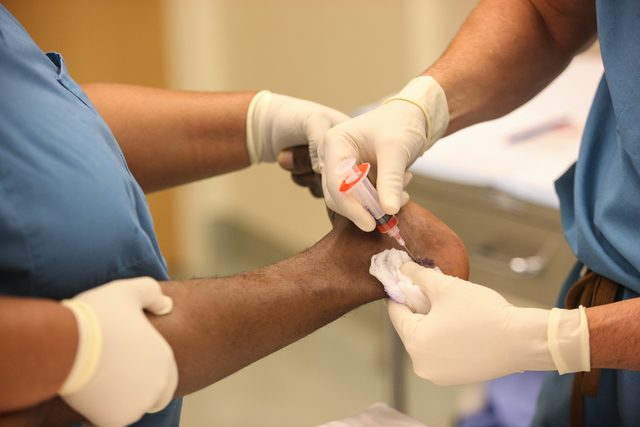Recovery formula, straight from your veins

When professional boxer Sharif Bogere aggravated a nagging Achilles injury during a fight in March, it seemed as though recovery would sideline his career indefinitely.
But Bogere decided to forgo traditional treatment — surgery — in favor of an experimental one that, until 2011, was banned by the World Anti-Doping Agency: platelet-rich plasma, also called PRP or blood spinning.
“I never heard of this before,” said his manager, Jimmy Alex. “I say if it will help, let’s try it. It’s better than surgery.”
The tried-and-true treatment for Achilles tendinitis is surgical repair, said Dr. Troy Watson, an orthopedic surgeon at Desert Orthopaedic Center. The recovery takes almost a year. But PRP, which isn’t invasive like surgery, can help speed recovery. Some patients may return to normal activity within a few weeks.
About three years ago, Watson began offering PRP to patients who had foot and ankle injuries. Recently, he administered it to a patient who had tennis elbow. It’s still experimental but many people have reported good outcomes from it, he said. Annually, more than 86,000 athletes receive PRP injections in the United States, according to the National Institutes of Health.
It was initially believed to give athletes a competitive edge because it contained growth factors, which is why it was temporarily banned by the World Anti-Doping Agency. That ban was lifted in 2011.
“The science behind it makes sense,” Watson said. “I think we’re really on the cutting edge with this.”
PRP is a procedure that uses the patient’s own blood as a healing catalyst. Watson draws a small amount of blood from the patient, then spins it in a centrifuge, separating the platelets from the red blood cells.
“Platelet-rich plasma has a bunch of growth factors,” Watson explains. “These are molecules that turn on other cells that help in the recovery process. We’re hoping they turn on the healing cells.”
Several pro athletes, including Tiger Woods, Hines Ward and Carmelo Anthony, have received PRP for various injuries. That has increased interest among the public, even weekend warriors, Watson said.
Las Vegan Glenus Cooper, 60, was training for a half-marathon two years ago when she injured her Achilles tendon. She continued to train, thinking she could just run through the pain. When it came time to run the race, she could barely walk. So she hobbled the 13 miles. That night, her calf throbbed and ached so much, she couldn’t sleep.
“I’m not one to go to the doctor for running injuries,” Cooper said.
That was her old attitude. Now, she understands just how debilitating a minor injury can become if not properly treated. Recently, she had an MRI that showed her Achilles tendon was torn. Her options were: live with it and limit her activities or have surgery.
Watson presented PRP as an option, too.
“To me, it sounded doable,” she said.
The procedure wasn’t covered by insurance so she had to pay the $500 on her own. But Cooper said the cost is a lot cheaper than surgery. After wearing a boot for four weeks to immobilize her foot, she was almost completely cured.
Cooper’s still taking it easy, alternating slow jogging with walking. But she completed a half-marathon in June and plans to do another one. She puts her recovery at about 99 percent.
Bogere had one PRP injection in March and wore a boot on his foot for a month. Though his mobility returned, he still felt pain so he went in for another PRP injection recently.
“I’m praying to God and everything to get better,” Bogere said. “I’m positive about it. I can’t wait to go back to work and do what I do best.”